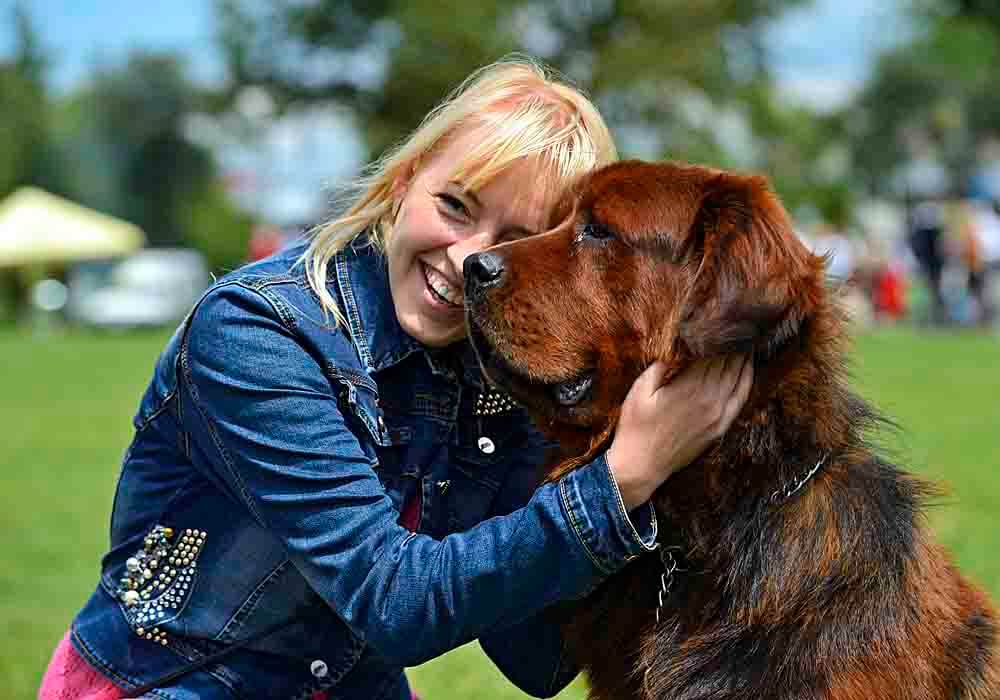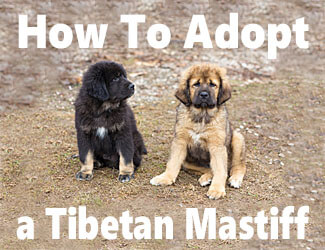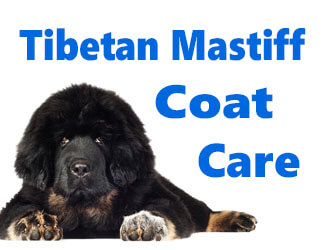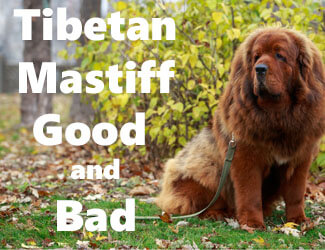Tibetan Mastiff Care Guide
From Puppy to Adult
by Ken Alden
The Tibetan Mastiff is a unique breed known to be very loyal and protective. Having specialized as guard dogs for centuries, Mastiffs have developed a highly sophisticated way of closely relating to humans. If you have recently acquired a Mastiff puppy, we think you'll benefit from the Tibetan Mastiff care guide as you'll no doubt be concerned about how to take care of his growing needs best.
Proper Tibetan Mastiff care from puppy to adult includes...
- Feeding high-quality food that covers all nutritional requirements
- Regular exercise
- Get him a top-quality dog bed
- Brush coat, teeth, and take for regular medical checkups
- Avoid arguing, scolding, or disciplining children in his presence
- Provide supervision when children are playing near your Mastiff
As your Mastiff grows, his needs will evolve as well, so you need to be prepared to adapt to his new requirements. This article gives you all the necessary information you need on how to provide him with wholesome care. Read More Below...
Pro-tip: Ever try lifting a Tibetan Mastiff? Their weight can hurt not only your back but their joints when they hop down from cars, sofas or even your bed. To protect your back and theirs check out the best Mastiff ramps on Amazon.com now.

How to Take Care of Your Tibetan Mastiff Puppy
For Adults Click Here
Taking care of your Tibetan Mastiff puppy might sound daunting at first, especially if you are a first-time pet owner. However, this need not be the case. Once you understand what you need to do and then start getting used to doing it, you will realize that your Mastiff is not that high-maintenance after all.
Once you bring your puppy home, a whole new life begins for both of you. After getting acquainted with each other, it's time to start working on creating a suitable environment for your puppy and providing his daily needs. Let’s get you started.
Below are general guidelines on how to take care of your Mastiff
puppy:
Grooming
Help your Mastiff puppy get accustomed to having his coat brushed or his body examined. Touch his paws often as well as dogs are not very comfortable with this. Lay the foundation for trouble-free veterinary exams later on by making grooming a pleasant experience. Use rewards as incentives for better cooperation too.

A groomed Mastiff is a happy Mastiff! We'll teach you how to groom your Tibetan Mastiff in this dedicated article here.
Diet
Mastiff puppies require a lot of food rich in protein, minerals, fats, and vitamins, necessary for their growth. Go for puppy specific dog food as it will supply your puppy with all the nutrients he needs.
Between 8-12 weeks, feed your puppy 3-4 times a day and twice a day after six months. Follow the directions on the dog food pack and adjust according to your puppy’s appetite. Maintain a regular schedule as well so that your puppy learns to eat at a particular time. tibetan mastiff care guide
Stay away from any canned food that contains artificial ingredients since this could cause chronic skin ailments. If you notice your Mastiff puppy scratching, a food allergy could be the culprit. From 9 months onwards, your Mastiff puppy can transition to adult dog food.
If you find yourself getting overwhelmed or unsure of how to
take care of your Mastiff puppy’s dietary needs, check in with your
veterinarian. Tibetan Mastiff care guide

These Mastiff feeding guidelines of ours are a great way to ensure a healthy pooch. For adults or for puppies
Pro-tip: Tibetan Mastiff anxiety, aggression, destructive chewing, jumping up, fearfulness, and other behaviors can be controlled with the right training program.
Here’s a great course that addresses these issues along with many other dog training basics: Check it out now!
Healthcare
Mastiff puppies are susceptible to Canine Inherited Demyelinative Neuropathy (CIDN), a fatal genetic condition. The disorder occurs in puppies aged between 7-10 weeks. The affected puppies tend to die by the time they are four months old.
Therefore, before you purchase your puppy, do your due diligence. Buy from a reputable dog breeder who will provide you with health clearances - for the puppy’s parents - to show that your puppy is free of genetic conditions.
Note that health clearances are only available for dogs that are over two years old. Therefore, you need to buy your puppy from a breeder who breeds his dogs after they are 2-3 years old.
Consider buying pet health insurance. This is particularly important since your pet will need various medical tests and procedures in his lifetime, and insurance will help cover the fees.
Physical Fitness
Nevertheless, when your puppy is less than 12 months old, take care not to overwork his growing bones, muscles, and joints by involving him in too much exercise. This is because Mastiff puppies only start maturing after they are about a year old.
To avoid the risk of orthopedic damage, restrict your puppy’s exercise to yard play, and avoid long walks. But from 3 months onward, it’s okay to involve him in half-hour romps or strolls in the backyard.

Here's a whole article dedicated to the exercise needs of the Tibetan Mastiff where you'll also find creative exercise suggestions.
Socialization
It is crucial to raise your Tibetan Mastiff puppy into an adult in a careful and well-balanced way. This will enable him to grow into a stable, well-adjusted dog. It also helps to avoid behavioral challenges in adulthood.
So, start training as soon as you bring your puppy home. Be patient with him when he gets headstrong and difficult to deal with, which will happen more often than you like. While socialization training begins at this point, it ought to continue to adulthood.
Mastiff puppies may act like big softies, but they still retain their innate guardian nature. Due to this, strangers need an introduction from a family member. Exposing your puppy to unfamiliar experiences like meeting people will help him become comfortable, well-adjusted, and self-confident. So will supporting him as he explores his new world. tibetan mastiff care guide
Take him on errands, to the park, long car drives, and on neighborhood walks. As your puppy grows, this training enables him to avoid being overly-protective when it comes to family members or domineering towards other dogs. He will also learn to be patient with children.
Furthermore, if raised with other dogs or cats, your Mastiff will get along with them well, even as an adult.
Ultimately, your dog is your responsibility, so do your best to ensure that he behaves well when away from home. Teach him good manners and, when possible, enroll your puppy in obedience classes.
Mastiffs thrive on routine as they are very sensitive to change. This means that you need to be consistent in your training regimen. Besides, they are suspicious of new and unfamiliar things, plus they tend to be aggressive with same-sex Mastiffs. This requires you to be extra careful whenever your Mastiff is around other animals.

Wanting to be thorough in this Tibetan Mastiff care guide, here's a whole page dedicated to socialization tips
Tibetan Mastiff Care Guide...
Caring For Your Mastiff Adult...
Provide Your Mastiff With Routine Care
Tibetan Mastiffs are independent, courageous, and fearless. Calm and quiet while indoors, especially if their needs are met, they will often bark a lot if left outside at night. As a result, they make excellent guards to both family and property.
To help your Tibetan Mastiff live a healthy and happy life, you need to ensure that you provide him with adequate care and good grooming. Some of the useful activities you need to engage in include the following:
- Give his coat a thorough brushing regularly; at least once a week and daily during winter when he ‘blows” his fur coat off
- Keep his teeth in perfect health by brushing them twice a week to remove tartar
- Bathe him as needed, clean the ears, and trim his nails 1-2 times a month to avoid them snagging the carpet
- Discourage children from screaming, yelling, or roughhousing in your Mastiff’s presence since this could distress him or he might mistake it for aggression
- Be on the lookout for unusual symptoms which could indicate ill-health such as ticks, loose stools, vomiting, or itchy eyes, and seek veterinary assistance when necessary
Offer Your Mastiff a Healthy Diet
There are several options when it comes to feeding your Mastiff. You can offer him:
- Dry, canned food
- Raw food
- Cooked food
Try out the different options until you settle on what works for him. And how will you know what works? From his clear, bright eyes, shiny coat, and high activity levels.
Feed your Mastiff on roughly 4 - 6 cups of high-quality dog food per day. Divide the amount into two portions and have your Mastiff consume it over two mealtimes. Keep in mind that it’s not unusual for your Mastiff to skip a meal when he is not hungry.
After vigorous exercise, avoid feeding your dog immediately to prevent bloat. (Bloating could also occur if he eats too fast). Regular feeding can resume after about an hour. Don’t forget to always avail of clean, freshwater.
Dogs, just like people, have different food requirements. Therefore, the actual amount of food your Mastiff eats depends on several factors. These include:
- Age
- Size
- Level of activity
- Metabolism
If your Mastiff is very active, he will need to eat larger quantities of food. However, don’t allow him to stay with a bowl of half-eaten food all day. Remove it once mealtime is over to allow him to learn how to eat his food all at once.
Ensure to maintain consistency in your dog’s diet. This includes avoiding sharing your food with your dog, as human food might lead to some nutrient deficiencies.
Thus, it’s advisable to stick to dog food only and feed your Mastiff on a high-quality diet that’s appropriate for his needs and age. Finally, keep his food and water bowl clean by washing them often.

Just what are the best foods for your Mastiff? We plunged paws first into answering this question here.
Pro-tip: Tibetan Mastiff's (and their owners) love dog crates…and for good reasons. Crates keep dogs from mischief while you're away, are perfect for house training, for traveling by car, and provide the dog a place to de-stress. Check out the best Mastiff crates on Amazon.com now.
Provide Your Mastiff With Training
Tibetan Mastiffs are intelligent and learn fast though strict obedience training doesn’t always bring the desired results. You see, Mastiffs tend to have a strong mind, so you need to be very firm and authoritative during training.
Your Mastiff can become stubborn, may not always rely on your guidance, and will even disobey if he feels he’s right. Hence it might be an uphill task to turn him into a well-trained family companion if you are not confident and consistent.
Try and give rewards for good behavior during training. For instance, offer food treats, toys, or praise words. A tummy rub also works. Keep alternating the treats and present the reward as soon as the good deed occurs to reinforce the positive action. Be consistent and patient, too; regular practice is essential to help your dog maintain the new skills.
If you have young children, your Mastiff might not allow their friends to visit as they are very territorial. As noted earlier, your Mastiff might take the yelling of playing children to be aggressive that would necessitate some action on his part. Besides, he might not even allow your children’s friends to visit.
To help socialize your Mastiff, take him to public spaces such as parks and dog-friendly stores to allow him to get used to meeting new people. This socialization ought to continue his entire life and start from when he is still a puppy, as noted earlier. So, have your friends come over, meet the neighbors, and take him for strolls in your hood to enhance his social skills.
Allow Your Mastiff to Play and Exercise
Tibetan Mastiffs are typically massive dogs with loads of energy. As such, they need to keep their mind and bodies active, or they quickly get bored and start to get into all sorts of mischief. Exercise is also essential for good health and as a way of keeping fit.
Mastiffs are inactive indoors, but if well exercised, your dog can adjust to apartment living. This would need to be a huge apartment, though, as his vast size can be limiting. Indeed, an adult Mastiff can weigh up to 170 lb (77 kg) and, with a good diet and exercise, can live to about 15 years.
Create an exercise routine and follow it consistently. For instance, you can take your Mastiff for 20-30 minute walks in the morning and evening every day. This works quite well with his general makeup as Mastiffs are more active at dawn and dusk.
However, make sure that you keep changing your route to prevent him from becoming territorial over his walking path.
Always remember to put him on a leash when walking outdoors because even though they are gentle and loving—especially with children—Mastiffs are distrustful of strangers. Their huge size makes them quite intimidating as well.
It’s a good idea to attach an identification tag to your
Mastiff’s collar. This can help with identification in the event he goes
missing.
Offer Your Mastiff a Place to Rest and Relax
Being a massive dog, your Mastiff will require ample space—preferably in the backyard - to rest and exercise. The area should also have a sturdy high fence since Mastiffs are notorious for climbing over fences and escaping - including high chain link fences!
Avoid leaving your Mastiff outside for too long as he might start to dig. This could make him turn aggressive and territorial. Another destructive behavior exhibited by bored and restless Mastiffs is chewing on furniture, shoes, or walls. This is especially true for Mastiff puppies who are habitual chewers.
Mastiffs are not suited to hot climates due to their thick furry coat. Always provide your Mastiff with shade and freshwater when he is in the hot outdoors. Don’t forget to include a big dog bed in a shaded corner of your yard. Additionally, ensure the place is warm and peaceful. tibetan mastiff care guide

A good dog bed will be loved by your pooch, but because of their size and weight not just any one will do...Here's our favorites
Attend to Your Mastiff's Health Needs
Make sure that your Mastiff undertakes all the recommended examinations and vaccinations. This will also allow him to get the necessary checkups and tests for conditions common to his breeds, such as hip and joint issues. Whenever he falls ill, take him to the veterinarian as soon as possible.
Is Tibetan Mastiff the Right Breed for You?
If you would like to buy a family dog but haven’t decided which breed to settle for, think through the questions below. Are you looking for a dog that is:
- Independent, protective, and loyal?
- Family-friendly, loving, and patient with children?
- Calm and quiet while indoors?
- Going to be with you for a long time (long life expectancy)?
- Strong-willed, noble, stubborn yet utterly devoted to you
- Eager to please but expects you to treat him like an equal rather than a pet?
- Looks imposing, intimidating, and whose agility belies his great bulk?
If you ticked all the above, then a Tibetan Mastiff is the ideal
dog for you. Besides, if you suffer from allergies, it’s comforting to know
that TMs do not shed their coat all year round. Still, be ready to collect lots
and lots of hair during that one time in the year when they shed
massively.
Tibetan Mastiff Care Guide...Final Thoughts
The Tibetan Mastiff is an excellent breed that thrives in a family setting. Beautiful, adorable, and dependable, a Mastiff has all the traits you’d wish for in a family dog. Though not usually recommended for newbie dog owners, with proper care, training, and the right environment, TMs can make amazing pets.
This giant super-intelligent, stubborn-yet-devoted companion can be a challenge, though, so brace yourself. Don’t be surprised if you find yourself plunged into a very interesting adventure.
Return to the top of this Tibetan Mastiff Care Guide page

About the Author...
Ken Alden, a dedicated Mastiff owner for over eight years, is acclaimed for his expertise in care, grooming, and training. Read more About Me and my dog Shadow.
- Mastiff Guide Home ›
- Tibetan Mastiffs ›
- Tibetan Mastiff Care Guide



